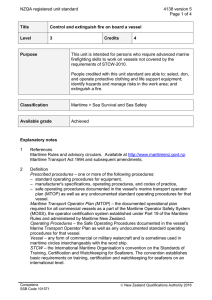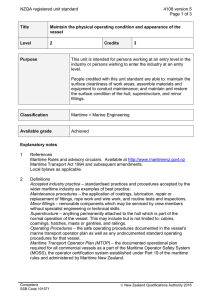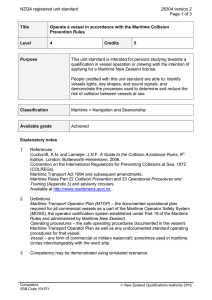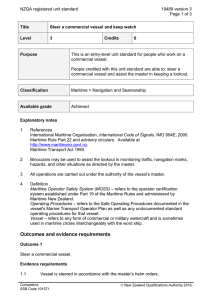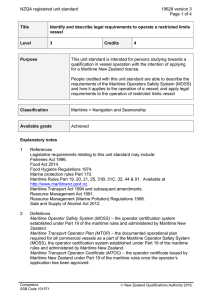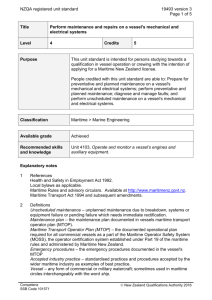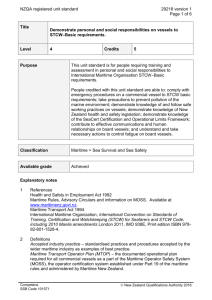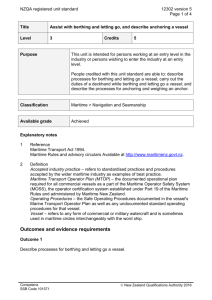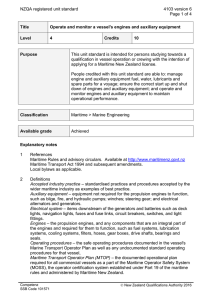Word - NZQA
advertisement
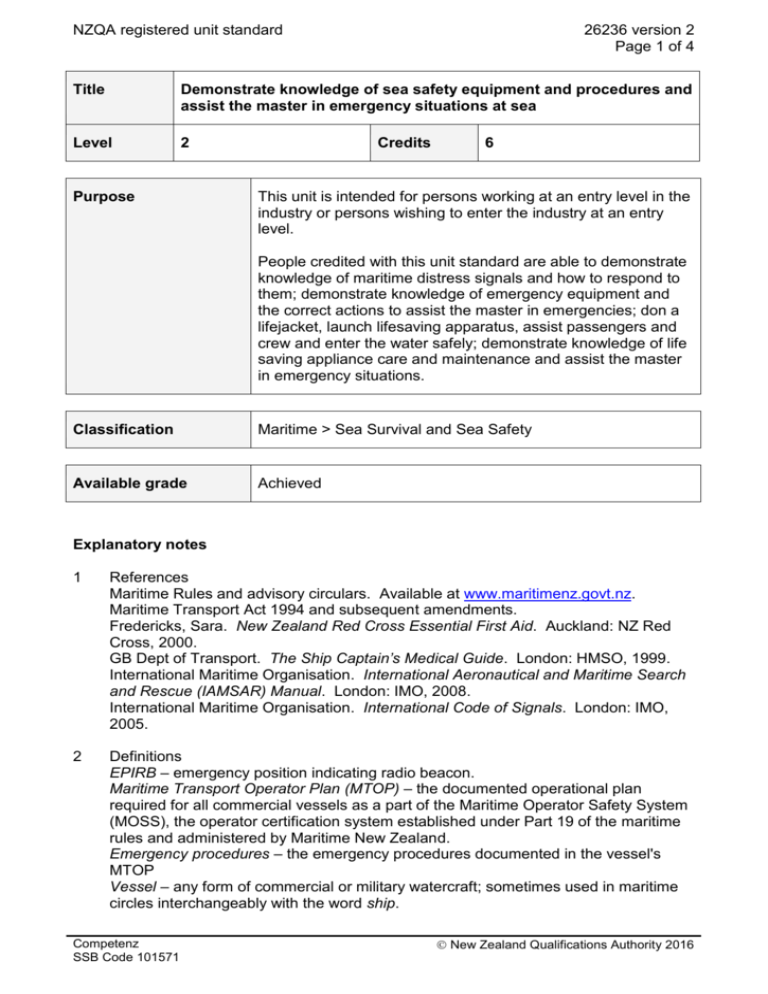
NZQA registered unit standard 26236 version 2 Page 1 of 4 Title Demonstrate knowledge of sea safety equipment and procedures and assist the master in emergency situations at sea Level 2 Purpose Credits 6 This unit is intended for persons working at an entry level in the industry or persons wishing to enter the industry at an entry level. People credited with this unit standard are able to demonstrate knowledge of maritime distress signals and how to respond to them; demonstrate knowledge of emergency equipment and the correct actions to assist the master in emergencies; don a lifejacket, launch lifesaving apparatus, assist passengers and crew and enter the water safely; demonstrate knowledge of life saving appliance care and maintenance and assist the master in emergency situations. Classification Maritime > Sea Survival and Sea Safety Available grade Achieved Explanatory notes 1 References Maritime Rules and advisory circulars. Available at www.maritimenz.govt.nz. Maritime Transport Act 1994 and subsequent amendments. Fredericks, Sara. New Zealand Red Cross Essential First Aid. Auckland: NZ Red Cross, 2000. GB Dept of Transport. The Ship Captain’s Medical Guide. London: HMSO, 1999. International Maritime Organisation. International Aeronautical and Maritime Search and Rescue (IAMSAR) Manual. London: IMO, 2008. International Maritime Organisation. International Code of Signals. London: IMO, 2005. 2 Definitions EPIRB – emergency position indicating radio beacon. Maritime Transport Operator Plan (MTOP) – the documented operational plan required for all commercial vessels as a part of the Maritime Operator Safety System (MOSS), the operator certification system established under Part 19 of the maritime rules and administered by Maritime New Zealand. Emergency procedures – the emergency procedures documented in the vessel's MTOP Vessel – any form of commercial or military watercraft; sometimes used in maritime circles interchangeably with the word ship. Competenz SSB Code 101571 New Zealand Qualifications Authority 2016 NZQA registered unit standard 26236 version 2 Page 2 of 4 Operating procedures – the safe operating procedures documented in the vessel's MTOP as well as any undocumented standard operating procedures for that vessel. Outcomes and evidence requirements Outcome 1 Demonstrate knowledge of maritime distress signals and how to respond to them. Evidence requirements 1.1 All distress signals are identified in accordance with Maritime Rule Part 23 Operating Procedures and Training, Appendix 3. 1.2 The response to receipt of a distress signal is described in accordance with the procedures contained in the vessel’s Maritime Transport Operator Plan (MTOP). Outcome 2 Demonstrate knowledge of emergency equipment and the correct actions to assist the master in emergencies. Range fire, abandon ship, “Man Overboard”, medical emergencies. Evidence requirements 2.1 Lifesaving appliances normally carried on vessels are described in terms of their location on a vessel, method of deployment, and intended emergency use in accordance with manufacturer’s specifications and vessel operating procedures. Range 2.2 buoyancy apparatus and/or life-rafts and life boats. Actions in the event of an emergency are described in accordance with the vessel’s operating procedures. Range distress signalling equipment includes – EPIRB, flares and smoke signals. Outcome 3 Don a lifejacket, launch lifesaving apparatus, assist passengers and crew, and enter the water safely. Evidence requirements 3.1 The use of life saving appliances carried aboard the vessel is demonstrated in accordance with manufacturer’s instructions. Range Competenz SSB Code 101571 life jackets, life buoys; other lifesaving appliances carried on the vessel. New Zealand Qualifications Authority 2016 NZQA registered unit standard 26236 version 2 Page 3 of 4 3.2 Lifesaving apparatus is launched and passengers and crew are assisted in its use in accordance with manufacturer’s instructions. 3.3 The candidate enters the water while wearing a lifejacket in accordance with vessel’s operating procedures. Range water entry may be from a vessel, wharf or poolside. Outcome 4 Demonstrate knowledge of life saving appliance care and maintenance. Evidence requirements 4.1 The description outlines the procedures for care and maintenance of life jackets and life buoys in accordance with manufacturer’s instructions. Outcome 5 Assist the master in emergency situations. Evidence requirements 5.1 The master is assisted in emergency situations in accordance with vessel’s operating procedures. “Man Overboard” drill, abandon ship drill, fire drill. Range Planned review date 31 December 2020 Status information and last date for assessment for superseded versions Process Version Date Last Date for Assessment Registration 1 18 June 2010 31 December 2016 Review 2 15 October 2015 N/A Consent and Moderation Requirements (CMR) reference 0054 This CMR can be accessed at http://www.nzqa.govt.nz/framework/search/index.do. Please note Providers must be granted consent to assess against standards (accredited) by NZQA, before they can report credits from assessment against unit standards or deliver courses of study leading to that assessment. Industry Training Organisations must be granted consent to assess against standards by NZQA before they can register credits from assessment against unit standards. Competenz SSB Code 101571 New Zealand Qualifications Authority 2016 NZQA registered unit standard 26236 version 2 Page 4 of 4 Providers and Industry Training Organisations, which have been granted consent and which are assessing against unit standards must engage with the moderation system that applies to those standards. Requirements for consent to assess and an outline of the moderation system that applies to this standard are outlined in the Consent and Moderation Requirements (CMR). The CMR also includes useful information about special requirements for organisations wishing to develop education and training programmes, such as minimum qualifications for tutors and assessors, and special resource requirements. Comments on this unit standard Please contact Competenz qualifications@competenz.org.nz if you wish to suggest changes to the content of this unit standard. Competenz SSB Code 101571 New Zealand Qualifications Authority 2016

